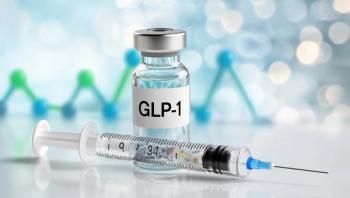
Real-World Data on Canagliflozin in Managed Care Setting Presented at ADA
Patients who received canagliflozin from their health plan showed significant A1C improvement, even though the study group had poor glycemic control despite treatment with multiple therapies. The study period covered the months immediately following FDA approval.
Canagliflozin quickly produced significant improvements in glycated hemoglobin (A1C) for patients with type 2 diabetes mellitus (T2DM) who received the drug through their health plan, according to results presented during Sunday’s poster session at the 75th Scientific Sessions of the American Diabetes Association in Boston.1
The drug produced noticeable improvement for patients who were typically being treated with at least 2 other therapies when they started canagliflozin. While the results from 826 patients were consistent with those in clinical trials, the degree of A1C improvement was still a pleasant surprise, according to Wing Chow, PharmD, MPH, the study’s lead author.
All patients in the study started canagliflozin in the 6-month window between April and October 2013, shortly after the drug received FDA approval on March 29, 2013.2 Researchers culled the data from the Optum Research Database, which captures claims data from UnitedHealth enrollees. Eligible enrollees had to be at least 18 and a diagnosis of T2DM for at least 6 months prior to the study period.
Dr Chow explained that because data collection was limited to no longer than 6 months after the first prescription, the average follow-up time was 112 days, well short of 6 months. Thus, she explained, the results achieved occurred in a very short period.
In the results presented Sunday, canagliflozin was prescribed to patients with a range of A1C levels that had remained uncontrolled, even though patients were taking an average of 2.3 antihyperglycemic agents, including injectables. Their mean A1C was 8.59% at the beginning of the study. The patients’ average age was 56 years, and 41% were women.
After being prescribed canagliflozin, patients had an average of 3.7 fills of the prescription and took the drug on 87% of the study period days. Patients had a mean A1C reduction of 0.81%, while those who had with higher A1C levels at the start of the period had greater reductions. The 270 patients with an average A1C of 10.51% were able to bring their level down an average of 1.81%, according to the results.1
Canagliflozin is the first in the class of sodium glucose co-transporter-2 inhibitors, which work differently from other treatments for T2DM, in that excess glucose is carried out of the body through the urine. The drug’s independent mechanism of action allows it to be used easily in combination with other therapies, including insulin. Besides the effect on A1C, SGLT2 inhibitors have been shown to help control hypertension; in some cases, physicians can cut back or eliminate separate blood pressure medication.3
The study was supported by Janssen Scientific Affairs.
Canagliflozin in combination. A second poster presented Sunday involved canagliflozin’s safety and efficacy in combination with metformin and insulin to treat T2DM.4 The CANVAS trial, a post-marketing study required by the FDA to monitor long-term cardiovascular outcomes, will run through April 2017; data presented at the poster session involved a subset of these patients.
The study evaluated 432 patients with T2DM at high risk of cardiovascular disease, who had a mean age of 61 years and a mean A1C of 8.2%. All patients were taking an insulin dose of at least 30 IU per day and a metformin dose of at least 2000 mg per day. The study group’s mean fasting plasma glucose (FPG) was 166 mg/dL, the mean body mass index was 34.9 kg/m2, and the mean insulin dose was 93 IU per day.
Compared with the 146 patients taking placebo, A1C went down significantly for patients at both the 100 mg (139 patients) and 300 mg doses (148 patients). All 3 groups started with a mean baseline A1C of 8.2%. The A1C level for placebo group went up by 0.03%; A1C for the group taking 100 mg went down by 0.64%, and A1C for group taking 300 mg went down 0.79%.4 In addition, both doses of canagliflozin produced better results for FPG, body weight, and systolic blood pressure than metformin and insulin alone.
The number of adverse events (AEs) related to the study drug was as follows: placebo, 18; canagliflozin at 100 mg, 31; and canagliflozin at 300 mg, 52. Adverse events that led to discontinuation were 2 for placebo, 2 for the 100 mg dose, and 6 for the 300 mg dose. Consistent with the SGLT2 inhibitor class, the most frequent AE reported were genitourinary infections. Incidents of hypoglycemia were similar in all groups: canagliflozin at 100 mg (42%), at 300 mg (47%) and placebo (46%).
References
1. Chow W, Buysman EK, Rupnow MFT, Henk HJ. Real-world outcomes of patients with type 2 diabetes mellitus (T2DM) treated with canagliflozin in a US managed care setting. Diabetes. 2015; 64: (suppl1) abstract 1337-P.
2. FDA approves Invokana to treat type 2 diabetes [press release]. Silver Spring, MD: FDA Newsroom; March 29, 2013.
3. Smith A. Studies are showing SGLT2s also help control hypertension, eliminate some side effects. Am J Manag Care. 2015; 21(SP5):SP156-157.
4. Rosenstock J, Matthews D, Desai M, Capuano G, Meininger G, Canovatchel W. Impact of canagliflozin added on to insulin and metformin in type 2 diabetes: a substudy of the CANVAS trial. Diabetes. 2015; 64: (suppl1) abstract 1292-P.
Newsletter
Stay ahead of policy, cost, and value—subscribe to AJMC for expert insights at the intersection of clinical care and health economics.















































